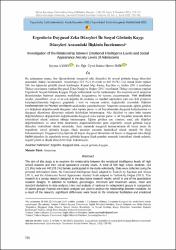| dc.contributor.author | Aydın, Şeyma | |
| dc.contributor.author | İmir, Hatice Merve | |
| dc.date.accessioned | 2023-09-11T13:07:10Z | |
| dc.date.available | 2023-09-11T13:07:10Z | |
| dc.date.issued | 24.06.2023 | en_US |
| dc.identifier.citation | Aydın, Ş. & İmir, H. M. (2023). Ergenlerin Duygusal Zeka Düzeyleri İle Sosyal Görünüş Kaygı Düzeyleri Arasındaki İlişkinin İncelenmesi . Afyon Kocatepe Üniversitesi Sosyal Bilimler Dergisi , 25 (2) , 723-741 . DOI: 10.32709/akusosbil.1034986 | en_US |
| dc.identifier.uri | https://dergipark.org.tr/tr/pub/akusosbil/issue/78272/1034986 | |
| dc.identifier.uri | https://hdl.handle.net/11630/10904 | |
| dc.description.abstract | Bu çalışmanın amacı, lise öğrencilerinin duygusal zeka düzeyleri ile sosyal görünüş kaygı düzeyleri
arasındaki ilişkiyi incelemektir. Araştırmaya 124 (%21,9) erkek ve 442 (%78,1) kız olmak üzere toplam
566 lise öğrencisi gönüllü olarak katılmıştır. Kişisel bilgi formu, Kayıhan ve Arslan (2011) tarafından
Türkçe uyarlaması yapılan Duygusal Zeka Ölçeği ve Doğan (2011) tarafından Türkçe uyarlaması yapılan
Ergenlerde Sosyal Görünüş Kaygısı Ölçeği kullanılarak veriler toplanmıştır. Bu araştırma nicel araştırma
desenlerinden betimsel araştırma modelinde kurgulanmış bir tarama araştırmasıdır. Veri analizinde
sayılar, yüzdelikler, en az ve en çok değerler ile ortalama ve standart sapmaların yanı sıra ikili grupların
karşılaştırılmasında bağımsız gruplarda t testi ve varyans analizi; değişkenler arasındaki ilişkinin
incelenmesinde ise Pearson korelasyon analizinden yararlanılmıştır. Araştırma sonucunda, eğitim görülen
yer değişkeni doğrultusunda duygusal zeka toplam puanı ve alt boyutlarından duygusal kolaylaştırma ve
duygusal düzenleme düzeyinde anlamlı farklılıklar bulunmuştur. Aile ilişkileri ve anne baba tutumu
değerlendirmesi değişkenleri doğrultusunda duygusal zeka toplam puanı ve alt boyutları arasında farkın
istatistiksel olarak anlamlı olduğu bulunmuştur. Eğitim görülen yer, cinsiyet, sınıf, aile ilişkileri
değerlendirmesi ve anne baba tutumunun değerlendirmesine göre ergenlerin sosyal görünüş kaygı
düzeyleri istatistiksel olarak anlamlıdır. Aynı zamanda duygusal tanıma/anlama alt boyut puanı ile
ergenlerde sosyal görünüş kaygısı ölçek puanları arasında istatistiksel olarak anlamlı bir ilişki
bulunamamıştır. Duygusal kolaylaştırma alt boyut, duygusal düzenleme alt boyut ve duygusal zeka ölçeği
toplam puanları ile ergenlerde sosyal görünüş kaygısı ölçek puanları arasında istatistiksel olarak anlamlı,
negatif yönlü ve düşük düzeyli bir ilişki bulunmuştur. | en_US |
| dc.description.abstract | The aim of this study is to examine the relationship between the emotional intelligence levels of high
school students and their social appearance anxiety levels. A total of 566 high school students, 124
(21.9%) male and 442 (78.1%) female, participated in the study voluntarily. Data were collected using the
personal information form, the Emotional Intelligence Scale adapted to Turkish by Kayıhan and Arslan
(2011), and the Adolescent Social Appearance Anxiety Scale adapted to Turkish by Doğan (2011). This
research is a survey research designed in the descriptive research model, which is one of the quantitative
research designs. In addition to numbers, percentages, minimum and maximum values, mean and
standard deviations in data analysis, t-test and analysis of variance in independent groups in comparison
of paired groups; Pearson correlation analysis was used to analyze the relationship between variables. As
a result of the research, significant differences were found in the emotional facilitation and emotional regulation levels of emotional intelligence total score and sub-dimensions in line with the place of
education variable. It was found that the difference between the emotional intelligence total score and its
sub-dimensions was statistically significant in line with the variables of family relations and parental
attitude evaluation. Social appearance anxiety levels of adolescents are statistically significant according
to the place of education, gender, class, evaluation of family relations and parental attitude. At the same
time, no statistically significant relationship was found between emotional recognition/understanding subdimension score and social appearance anxiety scale scores in adolescents. A statistically significant,
negative and low-level relationship was found between emotional facilitation sub-dimension, emotional
regulation sub-dimension and emotional intelligence scale total scores and adolescents' social appearance
anxiety scale scores. | en_US |
| dc.language.iso | tur | en_US |
| dc.publisher | Afyon Kocatepe Üniversitesi | en_US |
| dc.identifier.doi | 10.32709/akusosbil.1034986 | en_US |
| dc.rights | info:eu-repo/semantics/openAccess | en_US |
| dc.subject | Ergenlik | en_US |
| dc.subject | Duygusal Zeka | en_US |
| dc.subject | Sosyal Görünüş Kaygısı | en_US |
| dc.subject | Adolescence | en_US |
| dc.subject | Emotional İntelligence | en_US |
| dc.subject | Social Appearance Anxiety | en_US |
| dc.title | Ergenlerin duygusal zeka düzeyleri ile sosyal görünüş kaygı düzeyleri arasındaki ilişkinin incelenmesi | en_US |
| dc.title.alternative | Investigation of the relationship between emotional intelligence levels and social appearance anxiety levels of adolescents | en_US |
| dc.type | article | en_US |
| dc.relation.journal | Sosyal Bilimler Dergisi | en_US |
| dc.department | Seçiniz | en_US |
| dc.authorid | 0000-0003-2960-6164 | en_US |
| dc.authorid | 0000-0001-6230-3195 | en_US |
| dc.identifier.volume | 25 | en_US |
| dc.identifier.startpage | 723 | en_US |
| dc.identifier.endpage | 741 | en_US |
| dc.identifier.issue | 2 | en_US |
| dc.relation.publicationcategory | Makale - Ulusal Hakemli Dergi - Başka Kurum Yazarı | en_US |



















